Human parasites are called all organisms that live at its expense. These are bacteria, fungus, worms. Human parasites are divided into internal and external. The most unpleasant and the largest number of destruction of the body are helminths - a variety of parasitic worms.
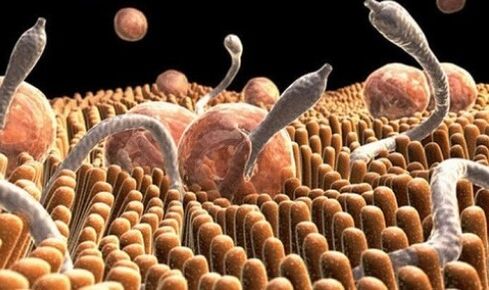
Parasites and human body
Creatures that parasitize on the human body can be external or internal. The exterior contains:
- Mosquitoes.
- Leech.
- Lice.
- Microorganisms that cause scabies.
But there are many more creatures that prefer to settle down in the body. This includes:
- Bacteria.
- Correct.
- Helminthen.
- Mushroom.
The external and internal organization of the parasite is easiest. Due to the fact that they do not have to develop to survive, their organization is very simplified.
There are many creatures that prefer to settle down in the body. For example, it can be bacteria.
You cannot survive without the guest body and cannot get your own food. But they all breed, almost without exception, very quickly, especially under the suitable conditions. Where they are not immediately driven by them.
Differ territorially. Some can be found everywhere, no climate for them is an obstacle. Others live exclusively in tropical countries, but they can easily be brought to any other on the human body. They also sit down in different places in the body.
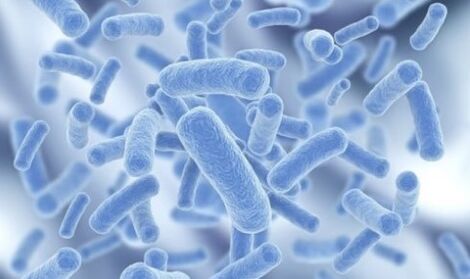
The cycles of the development of parasites, mainly helminthen, are also diverse. Some first develop in the ground (bio -hohlminthen) and then move to a living being. Others first have to develop in the body of another living being, but not in one person. Third, you can transfer to another or infect again in one adult state.
It is wrong to assume that an infection can only occur through dirty hands. Eggs of some helminths are viable for six months outside of the nutrient medium and adhere to animal wool. Eggs survive in a dangerous environment for them - it is worthwhile to incorrectly cooking or fishing meat when a whole brood of worms can be paid in them.
It is worthwhile to incorrectly cook meat as a whole brood of worms can be paid in them.
Endoparasites of a person
Parasites are divided into endoparasites and ectoparasites. Endoparasites - those on the inside, ecto - outside. Endoparasites can settle in almost all internal organs and body tissues. They are divided depending on the localization. Endoparasites are:
- Connection with the external environment of endoparasites internal organs.
They did not settle exactly in those organs connected to the external environment: the parasitic body is not selected to "breathe". Such organs include the intestine, the light and the human urine system. These are amoebas, worms and burning parasitaries.
- Parasites.
Set in human blood. They can live in plasma, white blood cells, red blood cells. These are tripanosomes, Microfilariae or Haemosporidia.
- Fabric endoparasites.
These endoparasites that choose the body of the body with their place of residence. Muscle tissue, brain, cartilage, binding effect. Even in nerve fibers, fabric endoparasites can settle. These are fins of the patrol worm, tripanosomes, Myxosporidia, Trichina and others.

Endoparasites can choose the brain with their place of residence.
The determination of the variety of parasites at the location of their localization is very limited. Many species are able to hike into different internal organs and to drive regularly through the owner's body. The propagation process can occur in one place, and organisms are diet directly and in another. The place where the parasite is justified and is considered a place of its conditional localization.
Despite the simplification of many parasite systems, your life cycle is quite complicated.
Some varieties for their life to survive have to change several owners who may refer to different biological species. Others are able to survive just a biological species inside, but they may need intermediate hosts. In one person they multiply and develop in another and grow up. With such a complex life cycle, your sexual functions are significantly increased. It is necessary to multiply quickly and much to survive in the body parasites.
Helminthen
There are three main varieties of Helminthen, also called worms. The:
- Nematodes, they are round worms.
- Cestoden, endoparasites of the band form.
- Trematodes, also known as Sterassen.
Next, you can be shared by the life cycle and the number of places where you will pass on this path. There are also three types:
Geo-hershminthen.
The earth is "ge". These worms begin their existence in the earthly soil, only after the maturation phase can they infect a person. You do not need intermediate hosts, eggs fall into the ground with human feces. They develop exclusively in the warm season on the larval stage.
Such worms include Ascarides, Darm Ugritsy, a non -core and the Blazo heads.
Larvae of these parasites can get into the human body through unwashed vegetables or direct contact with the floor.
Biohelminthen.
These are parasitic worms whose life stages go through several owners. Intermediate hosts can be two or more depending on the worms. Some parasites only change one person. Others before they finally get into the human body are used by organisms from other biological beings.
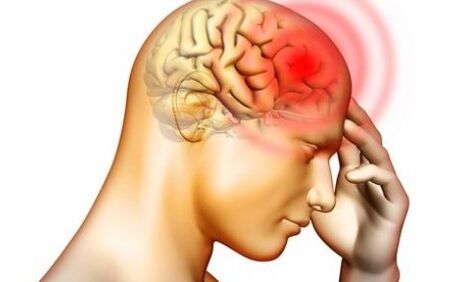
You can infect pets or in contact with other people, even if you consume half a meat. The organic mints include bull braces, Echinococcus, wide adhesive tape, Trichina and others.
Contagioine Helminthen.
These worms do not need a floor or intermediate owner. You pass all the phases of your life cycle in an organism, very comfortably located. Larvae stop directly from the human body when they contact household areas and other people and spread freely.
Helmins can live in various organs and systems of the human body and regularly wander from one part of the body to the other.
The list of diseases caused by helminths is very extensive. Determine which parasites live in the body and which treatment can only be started according to all analyzes required to determine the type.
Round worms
The most widespread in the human environment were round worms, also known as nematodes. In total there are more than 24, 000 types of nematodes in the world.
Because of their shape, they are round what is recognized when they make a cross -section. The most common human nematodes:
- Askarids.
- Speaker.
- Trichina.
- Blacovyv.
The helminthian invasion, known as ascariasis, begins with direct contact with the larvae infected in the soil or when using unwashed fruit and vegetables. Parasites begin to develop in the intestine, then enter a person's circulatory system from where you go to different inner organs that go into the oral cavity. A person who does not notice this is repeatedly swallowing an adult parasite. They feed on the remains of undigested food. The waste of the Ascaris is extremely toxic. There is no vaccine of ascariasis, an infection can only be prevented by observing the rules of personal hygiene.
Pinworm's infection is called enterobiasis. These are small worms (5-10 mm) that are attached to the walls of the intestine. They feed on the blood and content of the intestine. They put their eggs under their skin and climb out of the anal opening outside while the owner sleeps. Due to the itching, a person can comb the anal region, larvae fall under the skin and hands, can easily be transferred to other people in the house or in public locations. Enterobiosis has no painful symptoms, it is extremely problematic that the detection of plug -in needleworm infections in the early stages.
Trichinella, you are Trichina, these are round worms who choose an animal or a person with your master.
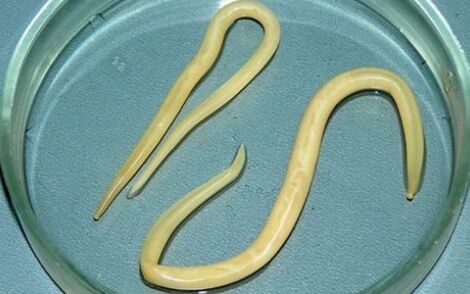
Trichinella is a parasitic worm that influences the human body and causes a dangerous reducing disease of trichinellosis.
They begin to develop in the area of the cross -striped muscles in the body and then divide them into the small intestine. In advanced cases of infections per kilogram of muscle tissue, around 15 000 trichinella eggs can be found. These parasites can cause a fatal disease named according to their source - trichinellosis.
Round worms of the Blazovians are called that because of their appearance. The front of your body is a filament, it contains a esophagus.
The back is wider, the remaining inner organs of the parasite are in it. The length of the blazoles can reach 50 mm. Blood and tissue fluid feeds on. Causes the disease of trichocephalosis.
Tapeworm
There are about 3, 500 species of famous patrol worms in the world, which are also called Cestoden. There are no digestive systems in these flat worms at all, and the diseases they cause are referred to as cestodosis.
The most common cestodossis:
Cystystyrcose.
The disease of the larvae of the pig band is stimulated and occurs in dirty food from dirty hands.
The disease influences skin, bones, inner organs, brain and spine brain. Most of the time, parasites are sent to the brain (in 60% of infection cases). Based on the occurrence of rounded formations on the skin, it is diagnosed. The disease is treated with an infection of the central nervous system, which can be unfavorable for forecasts.
Echinococcosis.
Liver in the liver, lungs, many other internal organs. Echinococcus larvae excite the disease. You can develop within a person for several years.
Infections occur in contact with animals, collect berries and fruits, consumption of contaminated water. The disease is not too striking, can develop for years and is only revealed by chance.
Alveocococoscoscose.
The alveococo is caused by alveocococococaratants. The disease resembles echinococcosis, but is more difficult. It affects lungs and kidneys. Without the treatment of the disease, there is a great probability of a fatal result in connection with the development of liver failure.
Toniarynchose.
The tusiarin chose is caused by a bull chain. The tapeworm in the area of the small intestine is parasitically and develops for 2, 5-4 months. Forecasts are more common for treatment. Parasites can get into a person with an infected raw or inadequate thermal meat.
Tapeworms are very fertile. They have reduced the rest of the sensitivity the most and there is no digestive system at all. Such parasites cannot develop without the owner.
Sosal worker
Supreme is tremontodes. These are flat worms in the form of your body, which resembles an elongated leaf of a tree.
Some types of trematodes can be one and a half meters tall.
And they are in the human body, they are most common through fish or other seafood. Around 7, 200 types of trematodes are known, 40 of them suffer from people and cause trematodoses, serious diseases caused by infections.
The most common salar:
The hepatic bicom.
Global often can exist in animals and people. The biological life cycle is complex, the parasite changes the owners.
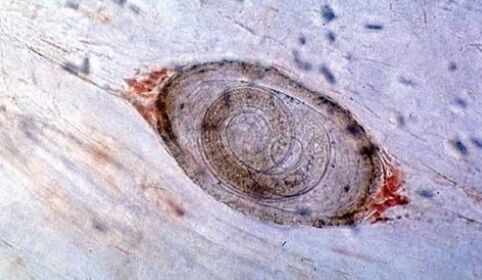
Schistosoma.
Schistosomen larvae can penetrate the skin or the mucous membrane. The life cycle is complex and feeds on blood. A woman can produce about 3rd 000 eggs a day, the fertility of these parasitic worms is very high.
Other liver balemers.
Opisthorchiasis, helminthen disease, which mainly spreads in the liver area. The human body has a toxic effect.
The digestive system of wormworm is well developed and with IT-sexual and excretion. The rest of the systems develop poorly. Tremontodes feed on blood, epithelial skin cells, the contents of the intestine. You can live almost anywhere: from the liver to the subjunctive eyes of the eyes.
Other types of endoparasites
The remaining inner parasites are a variety of bacteria that cause dangerous diseases and the simplest microorganisms with them. The fungus that spreads in the human body also refers to the section of endoparasites.
Many useful and harmful microorganisms live in the human body. Some of them cause rather dangerous diseases that can lead to death. It is not always possible to immediately recognize the presence of parasitic creatures in itself, but the early diagnosis of infection offers more opportunities to complete the healing. If the invasion is suspected, it is recommended to quickly examine yourself by a doctor.
























